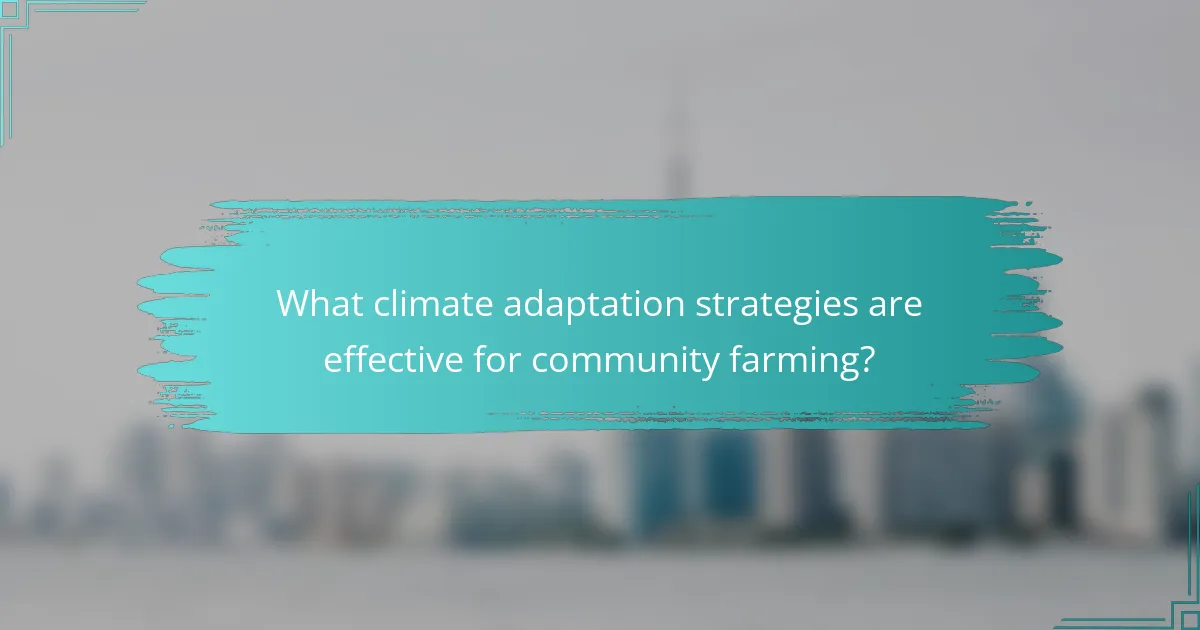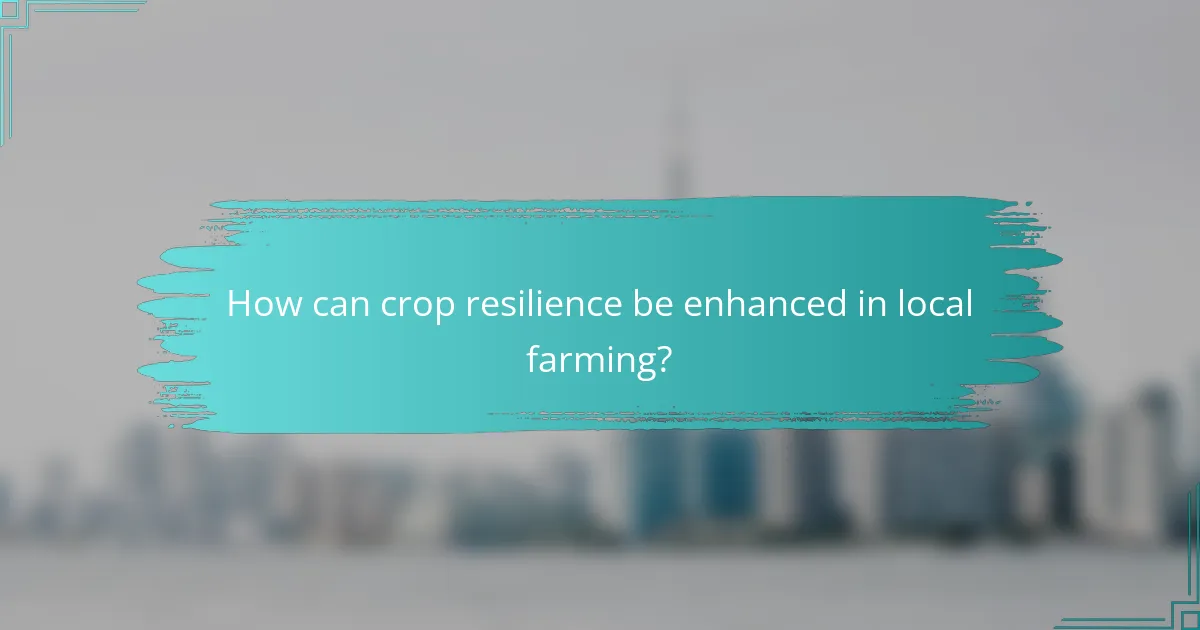Community farming initiatives are increasingly challenged by weather impacts that disrupt crop yields and sustainability. As climate change leads to more extreme weather events, farmers must adopt effective adaptation strategies, such as drought-resistant crops and improved soil management, to maintain productivity. By enhancing crop resilience through practices like crop rotation and integrated pest management, communities can better withstand the adverse effects of changing climate conditions.

How do weather impacts affect community farming initiatives?
Weather impacts significantly disrupt community farming initiatives by influencing crop yields, planting schedules, and overall farm sustainability. Changes in temperature, precipitation, and extreme weather events can lead to various challenges that farmers must adapt to in order to maintain productivity.
Increased crop failure rates
Extreme weather conditions, such as droughts or heavy rainfall, can lead to increased crop failure rates in community farming. These failures not only affect the immediate harvest but can also have long-term implications for soil health and community food security.
Farmers may consider diversifying their crops or implementing crop rotation strategies to mitigate the risk of total loss. Utilizing resilient crop varieties that can withstand adverse conditions is another effective approach.
Altered planting schedules
Weather variability often forces farmers to alter their planting schedules, impacting the timing of sowing and harvesting. For instance, unexpected frosts or prolonged wet seasons may delay planting, which can reduce the growing season and yield potential.
To adapt, farmers should monitor weather forecasts closely and consider flexible planting strategies that allow for adjustments based on real-time conditions. Utilizing tools like soil moisture sensors can help determine the best planting times.
Soil erosion and degradation
Heavy rains and strong winds can lead to soil erosion and degradation, which diminishes the land’s productivity. Erosion can wash away vital nutrients and topsoil, making it harder for crops to thrive.
Implementing conservation practices such as cover cropping, contour farming, and maintaining vegetation along waterways can help protect soil integrity. These methods not only reduce erosion but also enhance soil health over time.
Pest and disease proliferation
Changes in weather patterns can create favorable conditions for pests and diseases, leading to increased infestations and crop damage. Warmer temperatures and higher humidity levels can accelerate pest life cycles and expand their habitats.
Farmers should adopt integrated pest management (IPM) strategies that include regular monitoring, biological controls, and resistant crop varieties to combat these threats effectively. Keeping fields clean and practicing crop rotation can also minimize pest populations.
Water scarcity issues
Water scarcity is a pressing concern for community farming, particularly in regions experiencing prolonged droughts. Insufficient water supply can severely limit crop growth and yield, threatening food availability.
Farmers can implement water conservation techniques such as drip irrigation, rainwater harvesting, and mulching to optimize water use. Additionally, selecting drought-resistant crop varieties can help sustain production during dry spells.

What climate adaptation strategies are effective for community farming?
Effective climate adaptation strategies for community farming include the use of drought-resistant crops, water conservation techniques, improved soil management, agroforestry, and community education programs. These strategies help farmers mitigate the impacts of climate change and enhance crop resilience.
Drought-resistant crop varieties
Drought-resistant crop varieties are specifically bred to withstand periods of low water availability. These crops often have deeper root systems, thicker leaves, or other traits that allow them to conserve water and thrive in arid conditions.
Examples include certain strains of sorghum, millet, and legumes. Implementing these varieties can significantly reduce crop failure rates during dry spells, making them a vital component of climate adaptation in farming communities.
Water conservation techniques
Water conservation techniques are essential for maximizing water use efficiency in agriculture. Methods such as drip irrigation, rainwater harvesting, and mulching can help retain moisture in the soil and reduce evaporation.
Farmers should consider implementing these techniques to ensure sustainable water use. For instance, drip irrigation can reduce water use by up to 50% compared to traditional methods, making it a cost-effective solution for many community farms.
Improved soil management practices
Improved soil management practices enhance soil health and fertility, which are crucial for crop resilience. Techniques such as crop rotation, cover cropping, and reduced tillage can help maintain soil structure and nutrient levels.
These practices not only increase yields but also improve the soil’s ability to retain water. Farmers should regularly test soil health and adjust their management practices accordingly to optimize crop production under changing climate conditions.
Agroforestry integration
Agroforestry integration involves combining trees and shrubs with crops and livestock to create a more diverse and resilient farming system. This approach can improve biodiversity, enhance soil quality, and provide additional income sources through timber or fruit production.
Implementing agroforestry can also help mitigate climate impacts by providing shade and reducing soil erosion. Community farms can benefit from integrating native tree species that are well-adapted to local conditions.
Community education programs
Community education programs are vital for disseminating knowledge about climate adaptation strategies. These programs can provide training on sustainable practices, crop selection, and resource management tailored to local conditions.
Engaging local farmers in workshops and field demonstrations can empower them to adopt new techniques and share experiences. Building a network of support among farmers fosters resilience and encourages collaborative problem-solving in the face of climate challenges.

How can crop resilience be enhanced in local farming?
Enhancing crop resilience in local farming involves implementing practices that improve the ability of crops to withstand adverse weather and climate conditions. Strategies such as crop rotation, cover crops, and integrated pest management play crucial roles in building a robust agricultural system.
Crop rotation practices
Crop rotation involves alternating the types of crops grown in a particular area across seasons or years. This practice helps to prevent soil depletion, reduce pest and disease cycles, and improve soil fertility. For instance, rotating legumes with cereals can enhance nitrogen levels in the soil, benefiting subsequent crops.
Farmers should consider rotating crops based on their nutrient needs and pest resistance. A simple rotation plan might include planting corn one year, followed by soybeans, and then a cover crop like clover to restore soil health.
Use of cover crops
Cover crops are planted during off-seasons to protect and enrich the soil. They help prevent erosion, suppress weeds, and improve soil structure. Common cover crops include rye, vetch, and buckwheat, which can be sown after the main harvest.
Utilizing cover crops can significantly enhance soil moisture retention and organic matter content, leading to better crop yields in subsequent planting seasons. Farmers should aim to select cover crops that suit their local climate and soil conditions for maximum benefit.
Integrated pest management
Integrated pest management (IPM) combines biological, cultural, physical, and chemical tools to manage pests in an environmentally and economically sustainable way. This approach reduces reliance on chemical pesticides, promoting healthier ecosystems and crop resilience.
Farmers can implement IPM by monitoring pest populations, using resistant crop varieties, and introducing beneficial insects. Regular scouting and timely interventions can help maintain pest levels below damaging thresholds while minimizing environmental impact.
Soil health improvement
Improving soil health is fundamental to enhancing crop resilience. Healthy soil supports robust root systems, retains moisture, and provides essential nutrients. Practices such as adding organic matter, reducing tillage, and maintaining proper pH levels contribute to soil vitality.
Farmers should regularly test soil health and amend it based on specific deficiencies. Incorporating compost or well-rotted manure can significantly boost soil fertility and microbial activity, leading to more resilient crops.
Climate-smart agricultural techniques
Climate-smart agriculture focuses on adapting farming practices to changing climate conditions while reducing greenhouse gas emissions. Techniques include selecting drought-resistant crop varieties, optimizing irrigation methods, and implementing agroforestry practices.
Farmers can adopt these techniques by assessing local climate patterns and selecting appropriate crops and practices. For example, using drip irrigation can conserve water and improve crop yields in arid regions, while intercropping can enhance biodiversity and resilience against pests and diseases.

What role do local governments play in supporting community farming?
Local governments play a crucial role in supporting community farming by creating policies, providing funding, improving infrastructure, and fostering community engagement. Their involvement can significantly enhance the sustainability and resilience of local agricultural practices.
Policy development for sustainable practices
Local governments are responsible for developing policies that promote sustainable farming practices. This includes regulations that encourage organic farming, soil conservation, and water management. By establishing clear guidelines, they help farmers adopt methods that are environmentally friendly and economically viable.
For instance, policies may include incentives for farmers who implement crop rotation or use cover crops to improve soil health. These practices not only enhance crop yields but also contribute to long-term agricultural sustainability.
Funding and grants for initiatives
Local governments often provide funding and grants to support community farming initiatives. These financial resources can help farmers invest in equipment, technology, and training necessary for sustainable practices. Grants may cover a range of projects, from organic certification to community gardens.
Farmers can benefit from programs that offer low-interest loans or matching funds for specific projects. Understanding the application process and eligibility criteria is essential for accessing these resources effectively.
Infrastructure improvements
Investing in infrastructure is vital for enhancing community farming. Local governments can improve access to water, roads, and storage facilities, which are essential for efficient farming operations. Better infrastructure reduces transportation costs and increases the marketability of local produce.
For example, constructing community cold storage facilities can help farmers preserve their harvests longer, reducing waste and increasing profitability. Collaboration with local farmers to identify infrastructure needs can lead to more targeted improvements.
Community engagement and support
Engaging the community is key to the success of local farming initiatives. Local governments can facilitate workshops, training sessions, and events that educate residents about sustainable practices and the benefits of community farming. This fosters a sense of ownership and participation among community members.
Additionally, establishing farmer’s markets and local food networks can strengthen community ties and support local economies. Encouraging volunteer opportunities in community gardens can also enhance community spirit and awareness of agricultural issues.

What are the prerequisites for successful community farming initiatives?
Successful community farming initiatives require a strong foundation of collaboration, resources, and knowledge sharing among participants. Key prerequisites include access to suitable land, community engagement, and the establishment of clear goals and management structures.
Community Engagement
Community engagement is crucial for the sustainability of farming initiatives. This involves actively involving local residents in decision-making processes and fostering a sense of ownership. Regular meetings, workshops, and social events can help build relationships and encourage participation.
Access to Resources
Access to resources such as land, water, and funding is essential for community farming success. Initiatives should explore partnerships with local governments, non-profits, and businesses to secure these resources. For example, community gardens often benefit from grants or donations of materials and tools.
Knowledge Sharing and Training
Providing education and training opportunities is vital for enhancing skills and knowledge among participants. Workshops on sustainable farming practices, pest management, and crop rotation can empower community members. Collaborating with agricultural experts or local universities can also enrich the learning experience.
Clear Goals and Management Structures
Establishing clear goals and management structures helps ensure that community farming initiatives remain focused and organized. Setting specific, measurable objectives allows participants to track progress and adapt as needed. Forming committees or leadership roles can facilitate effective decision-making and accountability.
